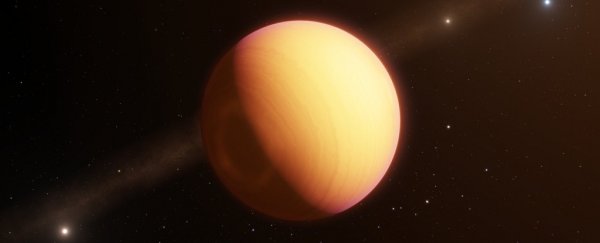Scorching temperatures of 880 degrees Celsius. Tempestuous clouds of iron and dust that envelop the entire planet in a global storm. Such are the conditions on HR 8799e, an exoplanet 129 light-years away - and the first to be studied directly using a technique called optical interferometry.
It's thanks to applying this technique that we have such a detailed analysis of the planet. Obviously, there aren't any lifeforms that we know of that would be able to call the hostile planet home - but HR 8799e does demonstrate the feasibility of using optical interferometry to search for habitable worlds.
Imaging exoplanets directly is a pretty big feat to begin with. Of the 3,926 exoplanets confirmed to date, only a few have been imaged directly. That's because they're very far away, and often too dim to be seen next to the light of their star.
The European Southern Observatory's Very Large Telescope (VLT) in Chile is one of the telescopes that has taken such direct images - but these pictures are too fuzzy to provide much detail about the conditions on the exoplanets.
Now optical interferometry data from the GRAVITY instrument on the VLT have provided 10 times the resolution of previous observations, allowing a much more detailed analysis of the planet's spectrum - which reveals its chemical composition.
The technique uses multiple instruments to overlay signals (usually electromagnetic waves, like optical or infrared light, or radio waves), amplifying the resolution. The Australian Square Kilometre Array Pathfinder is a radio interferometer, for example.
GRAVITY combines the capabilities of the VLT's four eight-metre Unit Telescopes to work as one giant telescope. The result is the equivalent of a single optical telescope with a mirror around 100 metres (328 feet) in diameter.
With this awe-inspiring amplification, astronomers have achieved unprecedented observations of HR 8799e.
The exoplanet is the innermost world in a four-planet system orbiting the young star HR 8799. It was discovered in 2010 via direct imaging using the WM Keck Observatory.
Based on previous observations, HR 8799e is quite chunky - between five and 10 times the mass of Jupiter. It orbits its star at about 14.5 astronomical units (AU) - compared to the Solar System that would be about mid-way between the orbits of Saturn and Uranus.
We also know it's a really young planet, only about 30 million years old (compare that to Earth's venerable 4.5 billion years).
So, as well as demonstrating the capabilities of optical interferometry for analysing planetary spectra, HR 8799e can perhaps shed some light on the early life of planets and planetary systems.
Using spectroscopy, which identifies the light signatures of chemical elements, the team determined that the planet is covered with clouds containing iron and silicates (the minerals that make up rocks). Because of this, HR 8799e is being super-heated by a greenhouse effect.
But there was a surprise in the planet's atmosphere.
"Our analysis showed that HR 8799e has an atmosphere containing far more carbon monoxide than methane - something not expected from equilibrium chemistry," said astronomer Sylvestre Lacour of Observatoire de Paris - PSL and the Max Planck Institute for Extraterrestrial Physics.
"We can best explain this surprising result with high vertical winds within the atmosphere preventing the carbon monoxide from reacting with hydrogen to form methane."
The combination of a carbon monoxide atmosphere and iron-and-silicate clouds produces colossal turbulence - a squalling storm that encircles the entire planet, which is glowing from within.
"Our observations suggest a ball of gas illuminated from the interior, with rays of warm light swirling through stormy patches of dark clouds," Lacour said.
"Convection moves around the clouds of silicate and iron particles, which disaggregate and rain down into the interior. This paints a picture of a dynamic atmosphere of a giant exoplanet at birth, undergoing complex physical and chemical processes."
Golly, doesn't that sound exciting.
The team is planning long-term follow-up observations with GRAVITY to try to trace out with even greater accuracy the exoplanet's orbit, revealing the gravitational effects the star and planet have on each other, along with the rest of the system.
This, in turn, will allow them to calculate with unprecedented accuracy the masses of HR 8799 and all its planets. What an incredible time to be alive!
The research has been published in Astronomy & Astrophysics.
